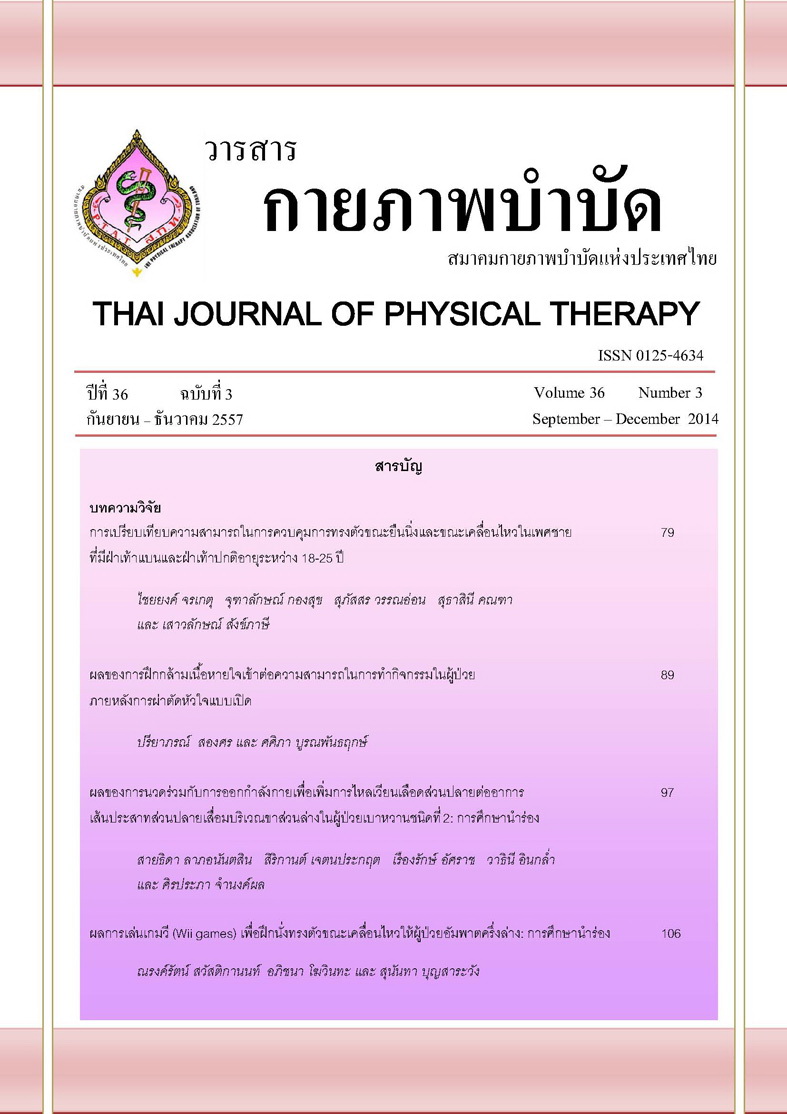ผลการเล่นเกมวี (Wii games) เพื่อฝึกนั่งทรงตัวขณะเคลื่อนไหวให้ผู้ป่วยอัมพาตครึ่งล่าง: การศึกษานำร่อง
Main Article Content
บทคัดย่อ
วัตถุประสงค์ของการศึกษานำร่องครั้งนี้เพื่อเปรียบเทียบประสิทธิภาพการนั่งทรงตัวขณะเคลื่อนไหวระหว่างกลุ่มที่ฝึกการนั่งทรงตัวโดยใช้เกมวี (Wii games) กับกลุ่มที่ใช้โปรแกรมทั่วไปฝึกนั่งทรงตัวในผู้ป่วยอัมพาตครึ่งล่าง ผู้เข้าร่วมการศึกษานี้ประกอบไปด้วยผู้ป่วยอัมพาตครึ่งล่างจากการบาดเจ็บไขสันหลังระดับT9-T12จำนวน 8 คน และมี ASIA Impairment Scale Aหรือ B โดยมีความบกพร่องการนั่งทรงตัวแต่ต้องสามารถนั่งโดยไม่ใช้มือประคองได้ 10 วินาทีผู้ป่วยทั้งหมดถูกสุ่มเป็นกลุ่มควบคุม (โปรแกรมฝึกทั่วไป) และกลุ่มทดลอง (เกมวี) ทั้งสองกลุ่มใช้เวลาการฝึก 20 นาที วันละ 2 ครั้ง เป็นเวลา 10 วัน ทดสอบการนั่งทรงตัวก่อนและหลังทดลองโดยใช้ modified maximal anterior balance range test (MMABRT) เปรียบเทียบระยะทางที่ได้ทั้งระหว่างกลุ่มและภายในกลุ่มโดยใช้สถิตินอนพาราเมตริก พบว่าทั้งก่อนและหลังฝึกไม่พบการเปลี่ยนแปลงภายในกลุ่มอย่างมีนัยสำคัญของ MMABRT ทั้ง2กลุ่ม และไม่พบการเปลี่ยนแปลงระหว่างกลุ่มอย่างมีนัยสำคัญของ MMABRT จากค่าเริ่มต้นและหลังฝึก การศึกษานำร่องครั้งนี้สรุปได้ว่า ผู้ป่วยอัมพาตครึ่งล่างระดับ T9-T12 และมี ASIA impairment scale A or B ไม่สามารถเพิ่มการนั่งทรงตัวขณะเคลื่อนไหวทางด้านหน้าได้ เมื่อใช้เกมวีหรือโปรแกรมการฝึกทรงตัวแบบทั่วไปนาน 10 วันควรมีการศึกษาเพิ่มเติมต่อไปโดยเพิ่มจำนวนผู้ป่วยและควบคุมความแตกต่างของผู้ป่วยให้น้อยลง
Article Details
เอกสารอ้างอิง
2. Seelen HAM, Potter YJM, Drukkker J, Reulen JP, Pons C. Development of new muscle synergies in postural control in spinal cord injuryed subjects. J Electromyogr Kinesiol 1998; 8: 23-34.
3. Chen CL, Yeung KT, Bih LI, Wang CH, Chen MI, Chien JC. The relationship between sitting stability and functional performance in patients with paraplegia. Arch Phys Med Rehab 2003; 84: 1276-81.
4. Boswell-Ruys CL, Harvey LA, Barker JJ, Ben M, Middleton JW, Lord SR. Training unsupported sitting in people with chronic spinal cord injuries: a randomised controlled trial. Spinal Cord 2009; 48: 138-43.
5. Lord SR, Menz HB, Tiedemann A. A physiological profile approach to falls risk assessment and prevention. Phys Ther 2003; 83: 237-52.
6. Sturnieks DL, Arnold R, Lord SR. Validity and reliability of sway meter device for measuring postural sway. BMC Geriatrics 2011; 11: 63.
7. Wikipedia. Wii. Available at: URL:http://en.wikipedia.org/wiki/Wii/. Accessed May 26, 2010.
8. Shih CH, Shih CT, Chiang MS. A new standing posture detector to enable people with multiple disabilities to control environmental stimulation by changing their standing posture through a commercial Wii Balance Board. Res Dev Disabil 2010; 31: 281-6.
9. Mhatre PV, Vilares I, Stibb SM, Albert MV, Pickering L, Marciniak CM, Kording K, Toledo S. Wii fit balance board playing improves balance and gait in Parkinson disease. PM&R 2013; 5: 769-77.
10. Mombarg R, Jelsma D, Hartman E. Effect of Wii-intervention on balance of children with poor motor performance. Es Dev Disabil 2013; 34: 2996-3003.
11. O’Sullivan SB, Schmitz TJ. Physical rehabilitation: assessment and treatment. 5th ed. Philadelphia: F. A. Davis Company. 2007. p. 254.
12. Boswell-Ruys CL, Sturnieks DL, Harvey LA, Sherrington C, Middleton JW, Lord SR. Validity and Reliability of Assessment Tools for Measuring Unsupported Sitting in People With a Spinal Cord. Arch Phys Med Rehabil 2009; 90: 1571-7.
13. Seelen HAM, Potten YJM, Huson A, Spaans F, Reulen JPH. Impaired balance control in paraplegic subjects. J Electromyogr Kinesiol 1997; 7: 149-60.


